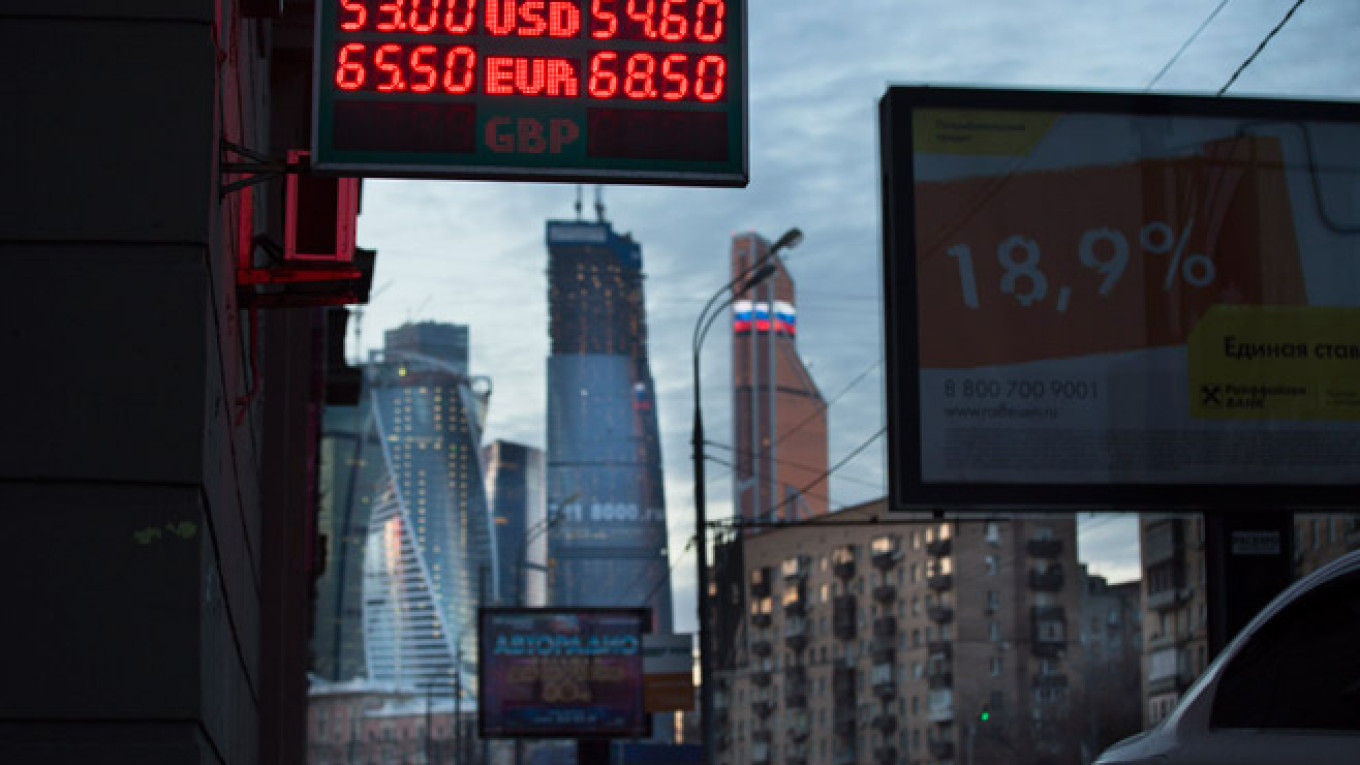The Russian ruble strengthened sharply Wednesday following a drop of more than 1 percent in morning trading, fueling speculation that the Central Bank had intervened on currency markets for a second time in three days.
The ruble strengthened 3.8 percent to 52.7 against the U.S. dollar in a matter of minutes shortly before 1 p.m., after weakening about 1 percent in the morning to new historic lows against both the dollar and the euro, according to data from the Moscow Exchange.
Volatile afternoon trading saw the ruble climb back up to almost 54 against the dollar, before settling at about 53 versus the greenback and 65.5 against the euro by 9 p.m. in Moscow.
The last time the ruble strengthened so dramatically was on Monday, shortly after recording its sharpest one-day fall for 16 years.
The Central Bank said Wednesday that it spent $700 million of its foreign currency reserves to reverse ruble declines on Monday — the first such intervention since the introduction of a fully free-floating ruble on Nov. 10.
The regulator releases information about currency market interventions with a two-day time lag.
The Central Bank, which has spent about $70 billion defending the ruble since January, said last month that now the ruble was free-floating, it would only intervene on currency markets if there was a threat to Russia's financial stability.
"Over the past 24 hours we have been seeing signs of contagion to other Russian markets — particularly credit, and it seems the Central Bank is worried that this could become vicious," Timothy Ash, an emerging market analyst at Standard Bank, said in an e-mailed note Wednesday.
Three currency traders said Wednesday that the Central Bank was selling foreign currency to support the ruble, Reuters news agency reported.
The likely intervention, and the ruble's strengthening, comes a day before President Vladimir Putin is due to give his annual state of the union address to lawmakers in the Kremlin.
Putin has said repeatedly that the Central Bank will not “mindlessly” burn through its reserves of foreign currency in bid to defend the ruble. Russia has about $420 of currency reserves left.
The ruble has dropped 3.7 percent against the greenback so far this week, extending months of weakness driven by a falling oil price, tanking economy and the effect of Western sanctions on Moscow.
Some experts have suggested that the Kremlin is happy to let the ruble fall as a way of maximizing revenues as the price of oil — on which Russia depends for half its budget revenues — plunges. A one ruble increase in the dollar’s exchange rate boosts government revenues by about 200 billion rubles.
One of the world's worst performing currencies, the ruble has tumbles 40 percent against the dollar since January.
Contact the author at h.amos@imedia.ru
A Message from The Moscow Times:
Dear readers,
We are facing unprecedented challenges. Russia's Prosecutor General's Office has designated The Moscow Times as an "undesirable" organization, criminalizing our work and putting our staff at risk of prosecution. This follows our earlier unjust labeling as a "foreign agent."
These actions are direct attempts to silence independent journalism in Russia. The authorities claim our work "discredits the decisions of the Russian leadership." We see things differently: we strive to provide accurate, unbiased reporting on Russia.
We, the journalists of The Moscow Times, refuse to be silenced. But to continue our work, we need your help.
Your support, no matter how small, makes a world of difference. If you can, please support us monthly starting from just $2. It's quick to set up, and every contribution makes a significant impact.
By supporting The Moscow Times, you're defending open, independent journalism in the face of repression. Thank you for standing with us.
Remind me later.


